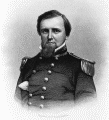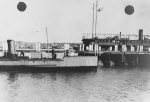Click On Image
For Full Size Image |
Size |
Image Description |
Contributed
By And/Or Copyright |
Namesake
|
 |
58K | William Gwin was born 6 December 1832 in Columbus, Indiana, and appointed a Midshipman 07 April 1847. One of the most promising officers in the nation, he had risen to the rank of Lieutenant Commander by the time of his death. During the Civil War he commanded several ships of the Mississippi Squadron. He was one of Flag Officer Foote's "can do" officers, displaying outstanding initiative, energy and dash. After the fall of Fort Henry he swept with his wooden gunboats up the Tennessee River all the way to regions of Alabama, spreading destruction and terror. This action was a major factor in the collapse Of the Confederate lines far behind him in Kentucky. Fire support from two of his gunboats, Tyler and Lexington, helped save Union troops from disaster in the Battle of Shiloh, bringing high praise from General Grant. He was wounded in action 27 December 1862 while commanding gunboat Benton in the Battle of Haines Bluff on the Yazoo River. He died from these injuries on board a hospital ship in the Mississippi River, 03 January 1863. | NHC |
Gwin (TB-16)
|
 |
139k | USS Gwin (Torpedo Boat No. 16) under construction at the Herreshoff Manufacturing Company, Bristol, Rhode Island, 1897. USS Talbot (Torpedo Boat No. 15) in the right center background, also under construction.
National Archives photo Photo #: 19-N-14-29-2 | NHHC |
 |
65k | Norfolk Navy Yard, Portsmouth, Virginia. Torpedo boats of the Atlantic Fleet Reserve Torpedo Flotilla at the Norfolk Navy Yard, circa 1907. Most of these craft are partially dismantled. The two boats in the front right and the one in the front left (listed in no particular order) are: USS Bagley (TB-24), USS Barney (TB-25) and USS Biddle (TB-26). The two larger boats between them, in the foreground are (left to right): USS DuPont (TB-7) and USS Porter (TB- 6). The three boats in the back row are (left to right): One of the three Torpedo Boat # 3 class (Foote, Rodgers or Winslow), USS Cushing (TB-1) and either USS Gwin (TB-16) or USS Talbot (TB-15). The receiving ship USS Franklin (1867-1915) and a two-masted schooner are in the distance.
Naval History & Heritage Command photo Photo #: NH 100042, courtesy of R.D. Jeska, 1984. | NHHC |
Cyane (YFB-4)
|
 |
73k | Cyane (YFB-4) undergoing bow repairs about the beginning of January 1922, after having accidently rammed the stone sea wall while coming into the Torpedo Station at Newport, Rhode Island. Cyane was repaired by Navy personnel by early March 1922 and returned to service. Note that she still wears her torpedo boat bow number ("16"), despite having been converted to a ferry several years previously. The original print is in National Archives Record Group 19, Entry 105, Box 192, File O-YFB4.
Naval History & Heritage Command photo NH 92311 | NHHC |
 |
447k |
Cyane (YFB-4), March or April 1922, following completion of repairs to her bow, damaged in a collision with the stone sea wall at the Torpedo Station, Newport, R.I.
Navy Torpedo Test Barge # 2 (built 1916) is in the right background. The original print is in National Archives Record Group 19, Entry 105, Box 192, File O-YFB4.
Naval History & Heritage Command photo NH 92313 |
Ramon Jackson |

